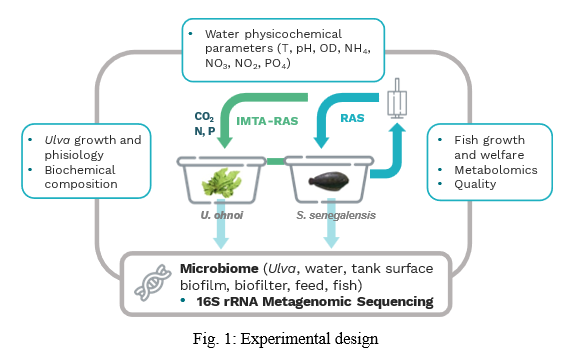A HOLISTIC AND COMPARATIVE STUDY OF THE MICROBIOME OF RAS OF SENEGALESE SOLE Solea senegalensis AND OF IMTA-RAS WITH SEA LETTUCE Ulva ohnoi
Introduction
Integrated Multitrophic Aquaculture in Recirculating Systems (IMTA-RAS) with macroalgae can mitigate the environmental impacts of fish production. Ulva spp. efficiently absorb nutrients, such as nitrate and phosphate, and transform them into biomass for food, feed or bioactive molecules. Moreover, the introduction of Ulva spp. can potentially modify the microbiome of the whole system. It is known that Ulva’s laminar blade offers support for beneficial bacteria, such as Phaeobacter spp., antagonists of fish pathogens. To understand the impact of Ulva on the system’s microbiome, a holistic analysis of the microbiome was conducted in a commercial-scale pilot scale system.
Materials and Methods
Two sequential trials were performed: one with sole fish (Solea senegalensis) in a RAS, and a second integrating sole with sea lettuce (Ulva ohnoi) (IMTA-RAS). The global microbiome of RAS and IMTA-RAS were compared using 16 rRNA metagenomic approach, which included samples taken from sea lettuce, sole (skin, gills, distal intestine mucosa), feed, , and the culture system (tank walls, biofilter and recirculating water). The study also included the analysis of parameters of the fish (growth, welfare markers and quality), the Ulva (growth and biochemical composition) and water (physicochemical parameters, nutrients) in order to establish, in future work, possible correlations.
Results
The results showed that the introduction of U. ohnoi significantly affects the microbiome of the system, including the one in the recirculating water, in the biofilter and in the biofilms of the tank walls, by altering both diversity metrics and taxonomic composition. Water samples taken before the biofilter consistently showed higher richness and diversity than those collected after ther biofilter, regardless of system type. Over time, beta diversity analyses revealed differences between RAS and IMTA-RAS in water microbiome at all timepoints and across compartments. Water in IMTA-RAS system was enriched in genera such as Ruegeria, Vibrio, Maribacter, Polaribacter, and Sulfitobacter. Some of these genera are associated with probiotic traits, biofilm stabilization, or antagonism against fish pathogens, suggesting potential health benefits. In the biofilter, microbial composition shifted temporally. At initial stages, Roseovarius dominated in RAS, while IMTA-RAS showed higher abundances of Maribacter, Sulfitobacter, and members of Bdellovibrionaceae. By the final sampling point, RAS was characterized by the presence of Hyphomonadaceae, whereas IMTA-RAS continued to support Rubidimonas and Sulfitobacter, the latter being consistently present and linked to sulfur metabolism and antimicrobial properties. Biofilms on fish tank walls also responded to U. ohnoi introduction. IMTA-RAS biofilms showed higher microbial richness and diversity, especially in early stages. Nitrospira, a genus involved in nitrogen cycling and known to contribute to biofilm stability, was dominant in IMTA-RAS, potentially enhancing system resilience. In contrast, RAS biofilms became dominated by Thiothrix at the final timepoint, a genus frequently linked to sulphide production and biofouling issues, which may indicate undesirable microbial development in RAS. These microbial shifts indicate that the inclusion of U. ohnoi may favour a more stable and functionally beneficial microbial community, potentially contributing to improved system health and pathogen resistance. Regarding the effect on fish, the analysis of the microbiome of Solea senegalensis is still ongoing. However, recent published results (Molecules 2025, 30(12), 2518) of metabolomic analysis of S. senegalensis muscle from those experiments revealed enhanced energy metabolism in IMTA-RAS systems, suggesting increased overall metabolic activity. These findings are promising, and upcoming microbial analysis may help establish a link between the systemic microbial environment and fish physiology, offering insights into the functional benefits of integrated multitrophic aquaculture.
Conclusions
The integrated analysis of the results will allow an understanding of the changes in the microbiome of the systems and demonstrate the potential effect of IMTA-RAS on fish health and welfare. By operating IMTA-RAS systems, the aquaculture sector could diversify, decrease its environmental footprint, and producing in a healthier way.
Acknowledgments/Funding
The project was funded through Xunta de Galicia with NextGenerationEU and the European Maritime Fisheries and Aquaculture Funds, within the Galicia Marine Science programme, Complementary Science Plans for Marine Science of Ministerio de Ciencia e Innovación, included in the Recovery, Transformation and Resilience Plan (PRTR-C17.I1). L.B. was beneficiary of a Juan de la Cierva Formación grant by the Ministerio de Ciencia e Innovación (FJC2021-047947-I). G.D.O was beneficiary of a grant from the Axencia Galega de Innovación (IN606A-2021/038).
